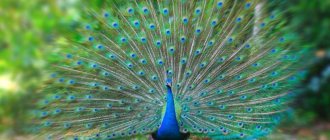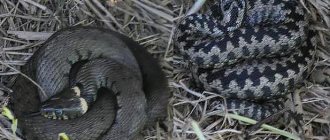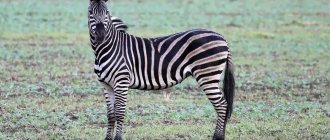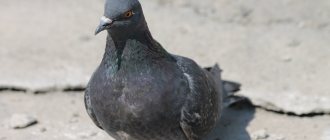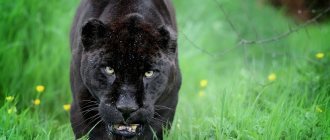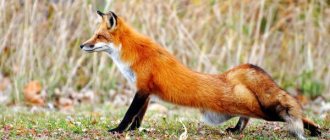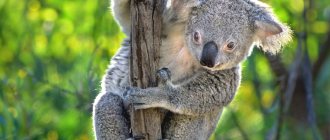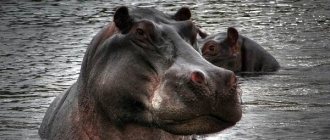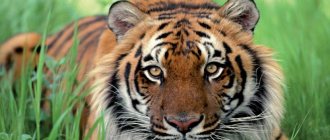Lions are legendary predators from the cat family. Only the tiger surpasses it in size. The natural habitat of lions is the African continent, south of the famous Sahara Desert.
A photo of a lion in the savannah is traditionally the “calling card” of Africa. However, due to constant extermination by local residents, their population is maintained only through protected areas.
There are about 50,000 lions left in total. About 2000 more predators live in cages (in a zoo or circus). Such a number of lions is a reason to think about their safety as a species on the planet.
Origin of the species and description
Photo: African lion
The African lion is a large predatory mammal, a prominent representative of the panther genus from the subfamily of big cats. All lions can be roughly divided into Asian and African, while the dimensions of individuals from the latter group are more impressive. This species evolved in Africa about 1 million years ago. Ancient fossils have been found in Italy in Europe, the age of which is estimated at approximately 700,000 years.
Experts have identified several subspecies of African lions:
- Barbary lions or North African lions are distinguished by their particularly large dimensions, but they are no longer found in the wild, as they were completely exterminated by humans. There are about a hundred Barbary lions in zoos around the world, but they can no longer be called purebred;
- Masai lions, the males of which are characterized by a very long mane;
- The Senegalese lion is the smallest of all African lions; it is this subspecies that is most similar to the Asian species;
- Congolese - lives in Uganda;
- Northwestern African lions are a large subspecies with a very light color;
- Transvaal lion - also distinguished by its impressive dimensions and long paws;
- The genetic differences between African and Asiatic lions are no more significant than the genetic differences between different human races.
Common lion subspecies
— Advertising —
Today there are 8 subspecies of lion:
- The Asian, Persian or Indian lion (Panthera leo persica) is a subspecies that lived in Turkey, southwest Asia, Pakistan, India and Bangladesh. Due to its diurnal lifestyle and large prides, it has become a convenient target for poaching. Today it is found exclusively in the Gir forest in India, where up to 300 individuals live.
- Barbary lion (Panthera leo leo) is extinct in the wild due to active hunting, but some individuals live in captivity. A large subspecies, the body length of males reaches 3-3.3 m, weight exceeds 200 kg. Previously it was distributed from Morocco to Egypt. The last wild Barbary lion was killed in Morocco in the early 20th century.
- The Senegalese or West African lion (Panthera leo senegalensis) is an inhabitant of western Africa, from Senegal to Nigeria.
- Northern Congo lion (Panthera leo azandica) - found in northeastern Congo.
- East African or Masai lion (Panthera leo nubica) - lives in the east of the African continent, in Ethiopia and Kenya, Tanzania and Mozambique.
- Southwestern African or Katangan lion (Panthera leo bleyenberghi) - its habitat is the southwestern region of Africa (Namibia, Botswana, Angola, Zaire, Zambia, Zimbabwe).
- The Southeast African or Transvaal lion (Panthera leo krugeri) is a subspecies of the Transvaal region of the Republic of South Africa, including the Kruger National Park.
- Cape lion (Panthera leo melanochaita) – became extinct in the wild in the mid-19th century.
Appearance and features
Photo: What an African lion looks like
Representatives of this feline species are characterized by external differences based on gender. Males are distinguished by their larger sizes and long, lush manes, which can grow up to 40 centimeters. In some subspecies, hair grows not only on the head, but also on the neck and chest, sometimes forming one single large mane. Senegalese lions have very sparse and short hair. All lions have a tail decorated with a small tassel, inside of which there is a small curved bone.
The body of lions is muscular and very flexible. Body size and weight depend on the subspecies. The maximum weight that was officially recorded was 370 kg with a body length of more than 3.6 m. The average weight of a male ranges from 180-220 kg, and of a female about 130-150 kg. At the withers, females reach 80-90 cm, and are slightly less than two meters long, excluding the tail. The height of males is about 120-125 cm with a body length of 2.5 meters.
Lions have fairly large eyes that are perfectly adapted to the dark. The jaws of predatory cats are very powerful, motionless to the sides. The large front canines are effective weapons during a lion hunt; they are designed to tear out pieces of flesh. Like all representatives of the cat family, lions never chew their food and swallow pieces whole. The lion's tongue is rough with a special bumpy coating, with the help of which the hunter separates bones from meat while absorbing food, and also catches ticks and fleas while washing.
The coloring of lions may vary slightly depending on the subspecies. There are individuals with both a milky beige color and a light brown body with an almost black mane. There are known cases of albino lions being born.
Now you know what an African lion looks like. Let's see where he lives.
Lion's mane
The main characteristic feature of the male is his mane, which is different for each individual: it can be very small, it can cover the muzzle, it can be huge and thick, covering the neck, head, shoulders, chest and continue along the stomach. It is believed that the thickness and size of the mane primarily depends on the genes, health and amount of testosterone of each individual individual. It is because of this feature that lions appear much larger than their size, which is very helpful in nature, scaring off other predators or representatives of their own species who are potential competitors. Some lions have dark, almost black manes - this gives the cats an incredibly majestic appearance, so it’s not for nothing that they are nicknamed “the kings of all animals.”
Wool
Overall the fur is yellow-gold. The fur is short, the tail is long and has a dark tuft of hair at the end. There are no markings in the form of stripes or spots, like other cats, on the bodies of lions, and if there are, they are weakly expressed. This helps large predators remain invisible in savannas.
Interesting fact : without fur, the bodies of lions and tigers are so similar that only experts can tell them apart.
Lion size and weight
Lions are very large cats, they reach a height of 1.2 meters at the shoulders, body length is usually around 3 meters, and the tail is from 60 to 91 centimeters. Male lions weigh from 150 to 250 kilograms . Females are much smaller - they grow up to 2.7 meters and weigh from 120 to 180 kilograms.
Interesting fact : The white lion is a rare mutation of the common lion with a genetic disorder called leucism, which is caused by a double recessive allele. This is not an albino; He has normal pigmentation in his eyes and skin.
Leo: general characteristics
Lions are carnivores and belong to the big cat family. These are one of the largest and most powerful animals on the planet, whose height ranges from 1 to 1.2 meters, and they weigh 90-250 kg.
Of all the representatives of the cat tribe, lions are the only ones who live in prides, that is, groups with a complex organization and patriarchal structure. It is the collective way of life that helps these cats survive in the wild. After all, despite their external strength and power, lions are not the most skilled hunters. And the hearts of such large animals are small and weak, so lions certainly cannot boast of endurance and the ability to run long distances.
One of the main features of these animals is their pronounced sexual dimorphism. Unlike other felines, a female lion can be easily distinguished from a male lion, since male lions have an attribute such as a mane. It is the mane that gives the lion a regal appearance, crowning his head with a crown and falling over his shoulders and back like a luxurious mantle.
A lion's mane begins to grow from the age of 2, and the older the male, the more magnificent it is. Scientists have also found that the length of a lion's hair depends on the level of testosterone, and if a male is castrated at a young age, his mane will not grow at all.
Male lions can sleep up to 20 hours a day. After waking up and before the start of the hunt, the formidable predator announces the surroundings with its powerful roar, which is heard at a distance of 8 km, and brings awe and indescribable horror to the rest of the inhabitants of the savannah. By the way, lions also roar. Warning the pride about a possible threat, females and cubs will always distinguish the voice of their leader from the roar of a stranger.
Lviv cannot be called long-livers. In the wild, they live from 10 to 15 years, and females have a better chance of reaching such a respectable age, because males often die as a result of battles with their fellow tribesmen, and leaders expelled from the pride face starvation, or they will become victims of other predators.
Elena
Ask a Question
Question to the expert
Who is bigger - a lion or a tiger?
In terms of constitution, build and weight, these cats are almost identical. But the lion has greater height at the shoulders, and due to the mane it seems larger than the tiger
Habitat of lions
Scientists have found evidence of lions living throughout almost all of Africa, parts of Europe and Asia. During the Pleistocene era (from 2,600,000 to 11,700 years ago), lions spread throughout North America and Africa, the Balkans, and also through Anatolia and the Middle East to India. Genetic studies suggest that the lion evolved in eastern and southern Africa, diverging into a number of subspecies such as the Barbary lion (Panthera leo leo) in North Africa, the cave lion (P. leo spelaea) in Europe, and the American lion (P. leo atrox) ) from North and Central America and the Asiatic lion (P. leo persica) from the Middle East and India - dating back to 124,000 years ago.
Habitat reduction
Lions disappeared from North America about 10,000 years ago, from the Balkans about 2,000 years ago, and from Palestine during the Crusades. By the 21st century, their numbers have dropped to several tens of thousands, and those individuals that are still found outside national parks are rapidly losing their habitat due to agricultural development. Currently, the main stronghold of the lion's range is in sub-Saharan Africa, and the Asiatic lion exists only as a remnant population of approximately 300 individuals inhabiting India's Gir National Park on the Kathiawar Peninsula.
Lions today remain only in isolated areas, which are just a drop in comparison with the range of the past. African lions are found only in small areas of sub-Saharan Africa, while a small population of Asiatic lions lives in a remote part of the Gir Forest in India. Despite the negative influence of humans and decline in numbers due to the destruction of their natural habitat, lions are extremely adaptable animals, able to survive in very dry climatic conditions, obtaining most of their moisture from food . Lions have been found in tropical forests (although they are not fans of very humid climates), and in extremely dry deserts. But still, these huge cats prefer to live in areas of open forest and large meadows, where they can not only find shelter among trees or in tall grass, but also a lot of food.
Conflicts that arise between local people and lions are the most serious problem in conserving the lion population. It is the villagers who are the main reason for the decline in the lion population. But despite such problems, lions remain the main attraction of many reserves, where their lives flourish. Although zoologists note that the increase in the number of lions can negatively affect local agriculture and also become a threat to other animals, including the cheetah.
Lion Spread
Initially, lions were distributed in the south of Eurasia, from Greece to India, in most of Africa, except for the Sahara and the forest zone.
The famous historian Herodotus described how lions attacked camels in Greece. But Aristotle already classified them as rare animals. And at the beginning of the new era, there were no more lions left in Greece. Asiatic lions were found in the Caucasus until the 10th century. In Palestine, these predators were exterminated in the Middle Ages, in other Asian countries - in the 18th century, when firearms appeared. By the beginning of the 20th century, lions became extinct in northern Africa and southwest Asia, Turkey and northern India. Now in Africa, lions live in savannas. In India, they are found in dry savanna and scrub forests. The Asian subspecies lives only in the Gir forest in India, but the population is gradually recovering.
Types of lions
Asiatic lion (Panthera leo persica)
Asiatic lion
They have noticeable tufts of hair on their elbows and at the end of their tail, powerful claws and sharp fangs with which they drag prey along the ground. Males are yellowish-orange to dark brown in color, lionesses are sandy or brownish-yellowish. The mane of lions is dark in color, rarely black, and shorter than that of the African lion.
Senegalese lion (Panthera leo senegalensis)
The smallest of sub-Saharan African lions, the lion inhabits western Africa from the Central African Republic to Senegal, numbering 1,800 in small prides.
Senegalese lion
Barbary lion (Panthera leo leo)
Barbary lion
Also known as the North African lion. This subspecies was previously found in Egypt, Tunisia, Morocco and Algeria. Extinct due to non-selective hunting. The last lion was shot in 1920 in Morocco. Today, some lions in captivity are considered descendants of Barbary lions and weigh more than 200 kg.
Northern Congo lion (Panthera leo azandica)
Northern Congo lion
Usually one solid color, light brown or golden yellow. The color becomes lighter from the back to the paws. The males' manes are a dark shade of gold or brown and are noticeably thicker and longer than the rest of the body fur.
East African lion (Panthera leo nubica)
East African lion
Found in Kenya, Ethiopia, Mozambique and Tanzania. They have less arched backs and longer legs than other subspecies. Small tufts of hair grow on the knee joints of males. The manes appear to be combed back, and older specimens have fuller manes than younger lions. Male lions in the highlands have thicker manes than those living in lowland areas.
South West African lion (Panthera leo bleyenberghi)
South West African lion
Found in western Zambia and Zimbabwe, Angola, Zaire, Namibia and northern Botswana. These lions are among the largest of all lion species. Males weigh about 140–242 kg, females about 105–170 kg. Males have lighter manes than other subspecies.
Southeast African lion (Panthera leo krugeri)
Found in South African National Park and Swaziland Royal National Park. Most males of this subspecies have a black, well-developed mane. The weight of males is about 150–250 kg, females - 110–182 kg.
White Lion
White Lion
Individuals with white fur live in captivity in the Kruger National Park and Timbavati Game Reserve in eastern South Africa. These are not a species of lions, but animals with a genetic mutation.
Black and white lions
A lion is an animal that has many interesting features. One feature concerns the coloring. Some classifications mention varieties such as white lion and black lion. But this is wrong. If a lion with a dark or black mane is a real existing subspecies, then animals with white or black coloring are considered an anomaly.
At the same time, it cannot be said that a lion with an exotic coloring is a fiction. There is a genetic mutation called leucism. Because of it, the fur of animals turns white. This occurs due to a lack of melanocytes. The result is the appearance of an animal such as a white lion. One might assume that this is an albino lion, but the color of its eyes, which can be either blue or gold, says otherwise.
The white lion is almost no different in its characteristics from other representatives of the species. It is slightly larger than the others. Their weight can reach 310 kg, and the male’s body length exceeds 3 m. The females of such animals are slightly smaller - 2.7 m. A lion with white fur changes color slightly throughout its life, and by old age its body acquires an ivory shade.
The black lion, according to many scientists, does not exist in nature. They consider photos and videos of such animals found online to be the result of shooting in the dark or special processing. Some suggest that, as opposed to albinism, there is a phenomenon of melanism, in which there is too much pigment in the fur of animals. This is possible in jaguars and leopards. As a result of crossing, a lion with a dark shade of fur may be born, but this is only an accident, so there is no need to separate such animals into a separate subspecies.
Lion behavior
Lions have a highly developed social organization compared to other cats. They live in large groups called prides. Adult males in their composition are engaged in protecting the territory. Female lionesses go hunting, usually at dusk, late in the evening or early in the morning. They rarely hunt during the day. Small animals are eaten immediately. Large prey is brought to the pride, where it is eaten along with other members of the group. In this case, sick and wounded animals are allocated a share on an equal basis with healthy individuals. Until the food runs out, the lionesses do not go on a new hunt. At this time, herds of antelopes and zebras may graze not far from the pride, but the lions will not touch them. Lions spend most of their time resting.
Features of character and lifestyle
Photo: African lion from the Red Book
Lionesses live longer than males. Lions are at the peak of their strength between 5 and 10 years of age; after reaching the maximum age of their activity, a very small proportion of males survive. African lions differ from other cats by forming a pride or a separate family group. A pride usually consists of several mature individuals and their offspring. Young lion cubs leave the parental group when they reach sexual maturity. They will become loners until they find a new pride with an old, weak leader, who in a duel will give up his rights to the strong and the young. Some lions remain nomads all their lives.
Pride has its own rules:
- everyone obeys the main male;
- foreign males and grown-up lion cubs are expelled;
- young females remain in the pride;
- males always jealously guard their territory, which is several square kilometers;
- females are the main value of males;
- family ties are the basis of relationships in a pride.
African lions are most active after sunset. When going hunting, females leave a “nanny” with the kittens. During the day, lions mostly rest; males walk around and mark their territory. A male who has his own pride is forced to constantly drive other males away from his females. Fierce fights occur very often. Even if the head of the pride did not die in a fight, but was kicked out, then most likely he is doomed to death either because of the wounds received in the skirmish or because of hunger.
Lion breeding
Pregnancy among lionesses of the same pride occurs at approximately the same time, so that the babies are born at the same time and it is easier to feed and raise them.
The duration of pregnancy is 110 days. To give birth, lionesses go away from the pride, to secluded places, dense thickets of bushes and caves. A litter contains 1-4 cubs weighing up to 2 kg. They are born blind and helpless. Lion cubs' eyes open at 10 days and they begin to walk at three weeks. Lionesses constantly go hunting and leave their babies alone. Periodically, they change their den so that predators cannot find the cubs by smell. A female with cubs usually comes to a pride 1.5-2 months after their birth. She feeds her offspring with milk for about six months. Attitudes towards children vary: mothers usually love girls more than boys. If the father of the cubs dies in a pride, then another lion kills the small male lion cubs. This may not affect the mother in any way, but she will always protect her daughters.
Young males at the age of 2-3 years (on reaching puberty) are expelled from their native pack and they begin a solitary life, create their own pride, or join someone else's pack. Sometimes an adult lion spends his entire life alone, but rarely, sometimes they live in pairs. Females spend their entire lives next to their mother. In any pride, all lionesses are related. There is a very high mortality rate among young lions. Only about 20% survive to 2 years, that is, 80 lions out of every hundred die.
The first birth in lionesses occurs at approximately the age of 4 years. The period of active life of the predator continues from 4 to 10 years, after which old age sets in. The lifespan of lions in the wild is up to 15 years. In captivity, it reaches 20-22 years.
Lifespan of a lion
One of the important aspects of describing these animals is the question of how long a lion lives. To answer it, you need to take into account many circumstances. How long a lion lives depends on features such as:
- Habitat. The better the living conditions, the longer its duration.
- Closeness to people. In close proximity to humans, the risk of extermination of these animals and shortening their lifespan increases.
- Features of life. Lonely individuals live shorter lives than those belonging to a pride.
- Floor. Females have a longer lifespan on average than males because they are less likely to die during fights with other lions.
All these nuances affect how long a lion lives. Therefore, their lifespan varies greatly. On average it is 8-10 years. Some individuals live up to 14 years.
How long a lion lives is greatly influenced by the behavior of people. It has much more impact than other factors. If people do not seek to destroy these animals, then their life expectancy increases. Better results can be achieved if you organize living conditions suitable for animals, for example, nature reserves or zoos. In this case, lions can live 20 or even 25 years, since they are monitored by veterinarians.
Body type
If you look at a photograph of a lion, you will notice that it is very similar to a big cat. This animal is the largest representative of the cat family. In size it can only be inferior to tigers.
He has a flexible and agile physique, with well-developed muscles in the neck and front pair of paws, on which claws are located, reaching a length of seven centimeters. A large head, an elongated muzzle and a powerful jaw distinguish this animal from the rest.
King of beasts. Structure and functions
Like other members of the cat family, the lion has a flexible, muscular body with a broad chest. The short, heavy skull and powerful jaws are excellently adapted for hunting and eating large prey. Lions search for prey using mainly their keen vision and hearing. In lions, as in many other cat species, adult males are significantly (30-50%) larger and heavier than females, which is probably explained by the intense struggle of males when competing for females.
As a rule, lions hunt together only when the probability that the predator will cope with the prey alone does not exceed 10%. Hunting together, lions disperse in different directions and partially surround the prey, cutting off its possible escape routes.
However, in other situations, only one or two lions of a family group go out hunting, while the rest of the pride watches from a safe distance. Single tactics are used much more often if hunting for prey is not particularly difficult.
A male lion delivers a suffocating bite while grabbing a zebra by the throat. Lions are among a fairly limited number of predators capable of killing prey weighing more than 250 kg. At the same time, they prefer to hunt not young, old or sick animals, but healthy adults. Lions also kill predators of other species, such as leopards, but never eat their corpses.
Although lions can reach a top speed of 58 km/h during a chase, their victims run at a speed of 80 km/h. Therefore, the lion must sneak up on the prey unnoticed and be no more than 15 meters away from it - only after this can it make a decisive throw and finish the attack, either by grabbing its victim or delivering a powerful blow to its side with its paw. When hiding prey, lions do not try to take into account the direction of the wind, although their hunt is much more likely to be successful if they approach the intended victim from the leeward side. Usually only one hunt out of four is successful. After a lion knocks down a large animal, it strangles its prey by squeezing its muzzle or throat in a fatal bite.
When sharing the prey, mature males dominate all other lions, and females play a dominant role in relation to cubs and young individuals. Clashes during feasts are quite common. To protect their share, lions cling to the victim's corpse with their teeth and drive away other members of the pride, slapping their fellow tribesmen in the face and often ripping out their ears. Adult females require 5-8 kg of meat per day, and adult males - 7-10 kg. However, lions feed irregularly and gorge themselves on huge amounts of meat no more than once every 3-4 days. An adult male can eat up to 43 kg in one sitting!
The mane of males begins to grow quite early - at the age of about two years, when they reach the size of adult animals, but its growth does not end there, and a full-fledged mane is formed in lions only by four to five years.
Teeth and tongue
A lion usually has 30 teeth in total. Its fangs reach 8 cm. Such physiological features are determined by the lion’s lifestyle and give it advantages in hunting large herbivores.
The lion's tongue is absolutely dry and has small tubercles that help it clean its fur, getting rid of dirt and small pests.
A lion. Pride. Laws of family and nature
Since ancient times, the power of the lion in the animal world . His depictions in cave paintings, sculptures, coats of arms and flags indicate strength and authority.
In Ancient Egypt, man saw the beast as a powerful god of the earth. To this day, he is called the king of beasts or the lion king , and is protected from the destruction of one of the largest and most interesting animals on earth.
Gender Differences
One of the main features of this species is sexual dimorphism. The female lion and the male have a number of significant differences from each other.
For example, the male’s head is crowned with an incredibly thick mane, which begins to appear in lion cubs from 6 months. Genetics and age determine how thick and long the mane will be.
Liger
The giant's name is Hercules, according to the Guinness Book of Records - this is the largest cat in the world. Hercules is a liger who weighs four hundred and ten kilograms and is almost two meters tall.
A liger is a hybrid between a male lion and a female tigress. Outwardly, he looks like a huge lion with blurry stripes. Male ligers have almost no mane, but unlike lions, they know how and love to swim. Another feature is that females can give birth to offspring, which is not typical for feline hybrids.
What does the African lion eat?
Photo: Predatory African lion
African predators hunt large zebras, wildebeests, African pigs, warthogs, reptiles and a variety of small animals, including rodents and birds. Representatives of the cat family do not hesitate to take prey from other smaller predators and pick up carrion.
Lions prefer to hunt in small groups at dusk and at night. They jump on top of the victim and immediately dig into the throat, trying to knock the prey to the ground as quickly as possible. The hunt ends successfully only in half of the cases. Lions do not run long distances due to their physiological characteristics - they have a very small and weak heart relative to their large muscular body.
Sometimes lions go hungry for several days. Each individual needs at least 7-9 kg of meat per day. They drink water willingly at every opportunity, but if it is not enough, they can do without it for up to 4-5 days, since they obtain the necessary liquid from food. Despite the fact that mainly only females hunt, males consume food first and only then do lionesses and young individuals. The eating process is always very noisy with fighting and growling.
If the prey is very large and strong, the male can join the hunt and help the lionesses. Solitary males, who do not yet have their own pride, go out hunting alone, but due to their impressive mane, it is not as effective as that of females, so they often choose lighter and smaller prey.
What do lions eat in the wild?
Lions are carnivores and their diet consists of food of animal origin. It’s not for nothing that these cats are called superpredators, because if a tiger can sometimes eat berries and herbs, and a bear mostly eats plants and insects, then the lion’s menu has only one dish - meat.
These predators feed exclusively on meat
The king of beasts prefers to eat fresh meat from an animal that has just been hunted, but he does not disdain carrion, especially during periods of famine. Moreover, the lion does not scour the savanna in search of a dead carcass, but is guided by flocks of vultures: if the birds dive to the ground, it means that they have spotted their prey, and the predator follows in the same direction.
Natural enemies of a lion
As for African lions, in nature they often conflict with hyenas due to a similar diet. Lionesses can take prey from hyenas. And the last thing to do is just step aside and wait until the predatory cats leave, having had their fill. A pack of hyenas may attempt to take the prey if there are few lionesses. Relationships between lions and leopards and cheetahs develop in a similar way. Either the strongest or the most numerous wins. Since other cats besides lions do not live in groups, they usually win. In addition, they attack the young of other species to eliminate competition for the future. The Nile crocodile remains a serious rival for lions. While the huge reptile is in the water, the lion cannot cope with it. The biggest threat to the predator population remains humans. But it can also save the species and subspecies from complete destruction by creating closed reserves with conditions safe for lions.
Cannibals are in danger. Conservation and Environment
Deaths due to lion attacks are quite common. Under natural conditions, man-eating lions attack people quite often, although, as a rule, such actions are decided by wounded or old animals that can no longer cope with ordinary victims. Many cases of cannibalism resulted from human destruction of lions' food resources. Thus, at the end of the 19th century, Europeans unintentionally introduced a livestock disease virus into the country, which destroyed not only domestic but also wild ungulates: as a result, lions almost completely lost their natural prey.
Although lions are not in immediate danger of extinction in the wild, the long-term outlook is far from encouraging. Many lions die as a result of illegal hunting. They accidentally get caught in snares that poachers set on other animals; shepherds place poisoned animal carcasses in lion territories, thus destroying entire prides.
A serious threat looms over the Asian subspecies of lion.
Interesting facts about the lion:
- The lion is an old and popular heraldic symbol, and is associated with royalty and nobility.
- The maximum weight recorded for a male lion was 370 kg. The maximum body length of this predator was 3.6 m.
- Leos are often called the “Kings of Beasts”. In the folklore and mythology of the inhabitants of Africa, this predator personified the highest divine power, power and greatness, power. In the traditions of Europe, it was a symbol of the power of the sun and fire, courage, valor, pride, nobility, justice, and triumph. The image of a lioness was more often associated with motherhood, mother goddesses, and voluptuousness.
How much does a lion weigh?
How much an adult lion weighs on average depends on the characteristics of its life. But gender especially affects this indicator. The differences in the main parameters are shown in the table.
| Males | Females | |
| Body length | From 1.7 to 2.5 m | From 1.4 to 1.45 m |
| Weight | From 150 to 250 kg | From 120 to 180 kg |
| Shoulder height | Approximately 1.2 m | Approximately 1.07 m |
| Tail length | From 0.9 to 1.05 m | From 0.7 to 1 m |
Despite its massiveness, this predator has the smallest heart size. Therefore, a lion cannot be called hardy. It can reach speeds of up to 80 km/h, but only covers short distances.
Population and species status
Photo: What an African lion looks like
There are currently 50,000 African lions in their natural habitat, and about 2,000 in zoos. The African lion was included in the Red Book by the international convention as an endangered species. The North African subspecies has already been completely exterminated by humans and can only be found in zoos.
According to available data, in the 60s of the last century, about 20 thousand African lions were killed by poachers in the Serengeti Park. Six countries on the African continent allow trophy hunting of these graceful animals. Hunters from all over the world flock to the savannas without thinking about the damage they cause to the lion population.
Despite the fact that lions do not normally hunt people, sometimes human casualties occur. On the African continent, about a hundred people die annually due to the fault of predatory cats; they usually attack sick or old males, for whom other prey becomes inaccessible. This fact additionally provokes an aggressive reaction from the local population towards lion prides and their shooting.
Interesting fact: The size of a pride of African lions is usually 15 individuals including cubs, but can reach up to 40 individuals. Among Asiatic lions, prides are divided into male and female, and sexually mature individuals contact only during the mating season.
Interesting varieties
A notable species of these animals is the mountain lion. It is not very similar to its other relatives; it differs in size and habitat. The mountain lion is distributed throughout America. Its body is from 1 to 1.8 m in length, and its weight can reach 105 kg. This is significantly less than other subspecies. The mountain lion also lacks a mane. Color can vary from gray-brown to brown-yellow. Cougar cubs are born with dark spots and stripes on their bodies, but after 9 months of life these markings begin to fade. The mountain lion prefers to live alone. The exception is the mating season and the time of raising cubs.
Another subspecies that may be interesting is the cave lion. It is included in some classifications, despite the fact that the cave lion is an extinct species, and it became extinct several thousand years ago. During their lifetime, these animals inhabited Siberia and Europe. The cave lion is one of the ancestors of modern lions. The cave lion was larger than its descendants. If you believe the images of these animals, they did not have a mane, or it was very small. It is not known for sure, but there is an assumption that this subspecies of animals also united in prides.
Despite its name, the cave lion never lived in caves. They were chosen by old and sick individuals shortly before death, which is why the largest number of remains of these animals were found there. That's why the cave lion was named so. The cave lion hunted deer and bears. This is how scientists explain the extinction of these animals. With the onset of warming, the number of bears and deer decreased, and the cave lion was not adapted to a different diet.
African Lion Conservation
Photo: African lion from the Red Book
The creation of national parks and reserves contributes to the conservation of African lions. The most significant are the national parks in Tanzania, Namibia, and the Kruger Park in South Africa. Outside these territories, lions are quite often killed by people due to the fact that they drag livestock. The closer a populated area is to the habitats of predatory cats, the greater the number of individuals that are shot.
The main negative factors affecting the population:
- changing of the climate;
- various diseases and human activities;
- loss of habitual habitats;
- conflicts with a person.
Individuals in western Africa are practically isolated from the Central African lion population and hardly interbreed with each other. Geographical isolation can lead to a sharp reduction in genetic diversity. To prevent this and rejuvenate the gene pool, scientists use artificial insemination methods. This process is very labor-intensive and complex, but there is no other way out yet. The practice is to introduce individuals from another population into new prides. Conflicts between individuals usually do not arise.
The African lion is quite successfully bred in artificial conditions, but according to experts, it has long been no longer purebred. Every person from childhood knows what a lion looks like, and already by its luxurious mane, a child recognizes the mighty king of beasts. Now the fate of this graceful animal completely depends on human actions. Time will tell whether the African lion population will be preserved or whether it can only be seen in a picture in a textbook, in a zoo.
Catastrophic reduction in range. Spreading
Panthera leo's range once covered a much larger area than it does now. Archaeological evidence shows that lions were widespread in Europe and North America before 10,000 years ago. Aristotle, who pointed out the relatively recent presence of lions in Greece, dates this fact back to 300 BC, and the crusaders often saw lions during their campaigns in the Middle East. Until the beginning of the 20th century, lions lived in most of the Middle East and northern India.
Like all other wild cats, lions are under the powerful influence of the rapid growth of the planet's population. Lions are large and easily visible animals, and in addition, they live in open biotopes; in this they differ from cats, which lead a more secretive lifestyle. Therefore, rural residents and farmers exterminated lions everywhere, rapidly displacing the predators from vast areas of their once continuous range. Nowadays, lions mostly live only within a few national parks and game reserves, where their populations are protected from human persecution.
Lions and people
Lions have no natural enemies other than humans, who have hunted them for centuries. Lions were once distributed throughout southern Europe and southern Asia east to northern and central India and throughout Africa.
The last lion in Europe died between 80-100 AD. By 1884, the only lions remaining in India were in the Gir forest, where only a dozen remained. They probably became extinct elsewhere in southern Asia, such as Iran and Iraq, shortly after 1884. Since the early 20th century, Asiatic lions have been protected by local laws, and their numbers have increased steadily over the years.
Lions have been wiped out in northern Africa. Between 1993 and 2015, lion numbers fell by half in Central and West Africa. In southern Africa the population remains stable and has even increased. Lions live in remote areas that are not inhabited by humans. The spread of agriculture and the increase in human settlements in former lion territories are the causes of the deaths.
Reproduction and raising of lion cubs
Sexual maturity in lions occurs quite late; they are ready for procreation only when they reach 4 years of age. Theoretically, adult lionesses can give birth several times a year, but they do not become pregnant until the previous litter is 2 years old. The exception is when all the offspring of a female die, then already a week after the death of the last baby, she can become pregnant again.
Mating season
Lions do not have a specific breeding season; they can mate throughout the year. These predators are polygamous, but, as a rule, limit themselves to sexual relations with their native pride. Lioness choose their leader as the father of their future cubs. If the family is ruled by 2 males, then the right to mate with all females goes to the stronger of them.
Leo is always ready to protect his females
Sometimes nomadic males lay claim to lionesses, and then the head of the pride is forced to fight with the uninvited guest and expel him from his territory.
Lion hunt
The lion is a large and carnivorous animal that survives only by eating other animals. Unlike other felines, lions are not solitary hunters, but instead lionesses work together to track and capture their prey, as each female plays a different strategic role. This strategy allows them to hunt animals that are both faster and much larger than them. Depending on the abundance and variety of prey species in their territory, lions primarily take gazelle, zebra and warthog, as well as a number of antelope species, following herds through open grasslands.
Feeding lions
What do lions eat? By their nature, these are predatory animals, which means they feed on large representatives of the fauna, among which the following can be noted:
- wild boars;
- deer;
- livestock;
- zebras;
- antelope;
- giraffes;
- buffalos.
An adult lion needs about seven kilograms of meat per day, and a female needs about five.
Who do lions hunt?
Lions hunt a wide variety of animals, from rodents and baboons to buffalo and hippopotamuses, although they generally prefer medium to large ungulates such as wildebeest and zebra. Food preferences may vary depending on the area of residence and each particular pride. Elephants and giraffes are also on the lions' menu, but these are mostly weak and stray individuals. They are willing to eat any meat they can find, including carrion. They also do not hesitate to steal from other predators - hyenas, cheetahs and wild dogs.
Lionesses live mainly in savannas and spend most of their time hunting, while the males appropriate the female's prey for themselves. But do not underestimate lions, who are no less mobile than lionesses, they are also dexterous and skillful hunters, who in some regions are often engaged in hunting along with females. Those prides whose territory is located in open forest zones often spend most of their time hunting, obtaining their entire diet on their own, thereby spending significantly less time with females.
While many consider a group of hunting lions to be the most formidable natural force on land, most hunts end in failure. Lions do not pay attention to the direction of the wind, which can carry the smells of predators over long distances, warning potential victims of an impending threat, and they quickly get tired after short runs.
As a rule, lions are in shelter, tracking down prey from there. At the moment when the animal passes close to the shelter, the cat launches its huge body into a dash in order to catch up with its future dinner, but such races are not designed to be long. When a lion catches up with its prey, it lunges at the neck and plunges its fangs, which it does not unclench until it strangles the victim or until the latter is exhausted.
Other members of the pride gather around the carcass and begin to eat together. Sometimes the prey is too small for the entire pride to approach at the same time, and then quarrels can occur, which often end in injury. The cubs are the last to start eating.
When hunting in a group, members of a pride surround large herds of animals, causing panic, due to which the victims are unable to form a defensive structure, becoming more vulnerable. After a successful hunt, lions often spend a couple of days resting. An adult male can eat up to 34 kilograms of meat at a time, and then rest for a week before starting to search for food again. If there are a lot of living creatures in the vicinity of the pride, then both sexes spend hunting almost around the clock, spending only 2-3 hours a day resting.
Interesting fact : Leos love to relax and laze around. They spend 16 to 20 hours every day resting and sleeping. They have few sweat glands, so they wisely seek to conserve their energy by resting during the day and become more active in the evening when it is cooler.
In most cases, lions absorb food on the spot, but sometimes they can drag it to a secluded place. A lioness needs to eat up to 5 kilograms of meat daily for a healthy life. Lions also protect food from other predators.
Hyenas and lions
An interesting relationship has developed between hyenas and lions. Their diet is almost 60% the same. Lions often ignore the presence of hyenas, while the latter have a pronounced reaction to lions in the surrounding area. Lions often take food from hyenas, thereby causing the latter to become more active in response. But hyenas, in turn, often wait on the sidelines of the pride, which is in the process of devouring the next victim, in the hope that after the insatiable lions there will be at least some food left.
These two species can come into conflict for no apparent reason; there is a number of evidence of an attack by a pack of hyenas on a lion. Lions can cause the death of 71% of hyenas. As the lion population in Kenya's Maasai Mara National Reserve declined, the spotted hyena's numbers rapidly increased.
Interesting fact : Experiments on spotted hyenas in captivity show that specimens without prior experience with lions act indifferent to their species, but they react with fear to the scent of a lion.
Lions tend to dominate cheetahs and leopards, taking their prey and killing their cubs and even adults when given the chance. A study in the Serengeti ecosystem found that lions killed at least 17 of 125 cheetah cubs born between 1987 and 1990. Lions also dominate African wild dogs, killing them and preying on young and rarely adult dogs. Lions have been observed killing crocodiles that dare to crawl onto the ground.
Social structure and reproduction
Photo: African lion cub
Unlike other mammals, lions mate at any time of the year and that is why it is quite common to see a female with cubs of different ages. By the age of 3-4 years, lionesses become capable of bearing offspring. Lions are polygamous and a male can mate with several females from his pride in order to leave as many offspring as possible and pass on his genes.
Pregnancy lasts about four months. As the important period approaches, the female retires to give birth to her cubs. The lioness hides the kittens that are born for six weeks, and only then brings them into the pride.
Usually 3-4 lion cubs are born. At birth they weigh no more than 1.5 kg. Babies open their eyes after 10-11 days, and only after a couple of weeks they begin to walk. The lionesses in a pride give birth almost simultaneously; they all feed the newborn cubs together and take care of them, forming a kind of nursery. Only after a year do the kids join the hunt and learn from the adults. Up to two years old, young males are protected by the main lion, and then they are expelled.
Interesting fact: If the previous head of the lion family was defeated by another male, then the newly arrived lion immediately kills all the cubs so that the females are ready for mating as early as possible. Males kill lionesses very rarely. In the wild, there have been cases when lionesses helped their main male drive away young singles.
Lion food
The diet of predators consists mainly of artiodactyl animals: livestock, antelopes, zebras and other savannah animals. The lion will not even let carrion or small rodents pass by. Despite the sharp and long fangs, the predator strangles its victims.
The ability to sneak up silently and then jump at the victim with lightning speed leaves no chance of salvation for many inhabitants of the savannah. The lion is strong and fast over short distances, so it gets as close as possible to herds for rapid leaps. This distance is approximately 30 m. Several predators of the same pride attack from different sides simultaneously.
Hunting takes place more often at night. One successful outing provides 4-5 pride animals with enough food for a week. The victims are ungulates weighing from 50 to 300 kg. In Africa, these are often wildebeest, zebras, and buffaloes; in India, wild boars and deer. Attacks on rhinoceroses or adult giraffes are rare due to the risk of injury.
The choice of prey depends on their availability in the region; in large individuals, the predator is interested in young animals or injured and weakened individuals. At one time, a lion can eat up to 30 kg of meat, although 7 kg for a male and 5 kg for a female are enough to satiate.
If prey needs to be preserved, then lions guard it from agile hyenas, attracted by the flight of vultures over the food. Hunting unites the pride: males come to the rescue in case of a large victim, and the offspring observe the actions of the adults.
Lion cubs begin to go out for their first hunting attempts at the age of 1 year, and from the age of 2 years they independently obtain food. Attacks on humans are typical for animals that have lost the ability to hunt ungulates.
